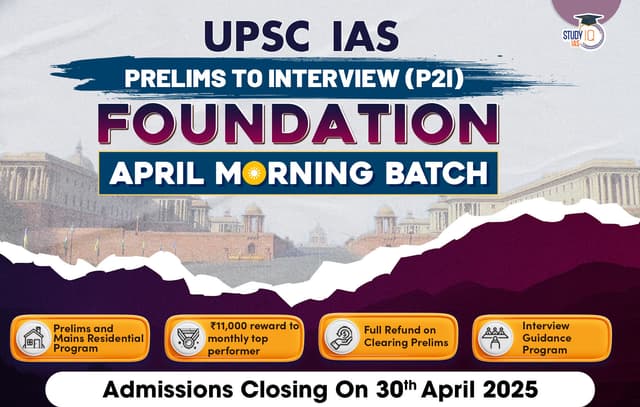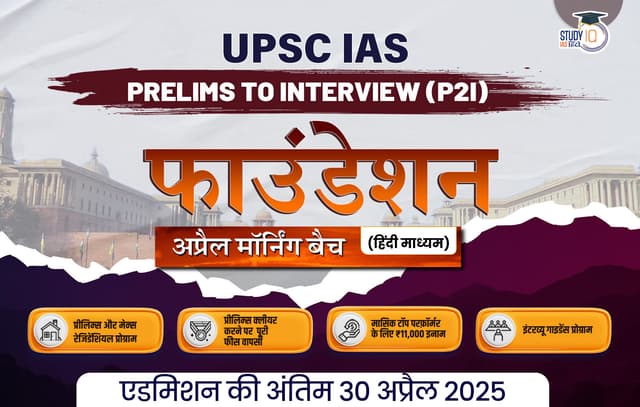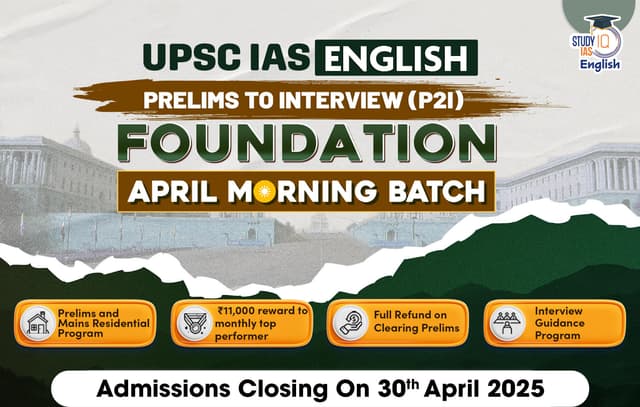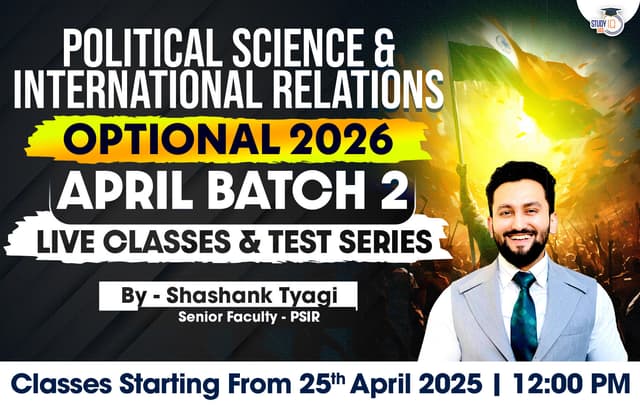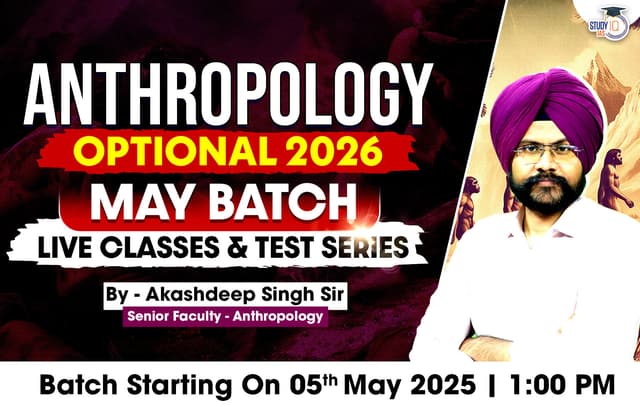Daily Quiz 30 November 2024
Quiz-summary
0 of 5 questions completed
Questions:
- 1
- 2
- 3
- 4
- 5
Information
- Click on – ‘Start Quiz’ button
- Solve Questions
- Click on ‘Next’ button
- Click on ‘Finish Quiz’ button
- Now click on ‘View Questions’ button – here you will see solutions and links.
- The test contains a total of 5 questions.
- Click on the most appropriate option to mark it as your answer.
- You will be awarded Two marks for each correct answer.
- You can change your answer by clicking on some other option.
- A Number list of all questions appears at the top side of the screen.
- You can access the questions in any order by clicking on the question number given on the number list.
- You can use rough sheets while taking the test.
- Do not use calculators, log tables, dictionaries, or any other printed/online reference material during the test.
- Do not click the button “Finish Quiz” before completing the test. A test once submitted cannot be resumed.
You have already completed the quiz before. Hence you can not start it again.
Quiz is loading...
You must sign in or sign up to start the quiz.
You have to finish following quiz, to start this quiz:
- 1
- 2
- 3
- 4
- 5
- Answered
- Review
-
Question 1 of 5
1. Question
1 pointsConsider the following rivers:
1. Zemu Chhu
2. Rangyong Chhu
3. Rangit River
4. Rani Khola
5. Sabari
How many of the above are Right bank tributaries of Teesta river?Correct
Answer: B
Explanation:
● Option (b) is correct: Teesta is the major river system in the State. Teesta river originates as Chhombo Chhu from a glacial lake Khangchung Chho at an elevation of 5,280 m in the northeastern corner of the state. The right-bank tributaries drain heavily glaciated areas with large snow-fields. The left bank tributaries, on the other hand, originate from semi-permanent and much smaller snow-fields as compared to right bank tributaries. The right bank tributaries of the Teesta River are: Zemu Chhu, Rangyong Chhu, and Rangit River. The Teesta River’s left bank tributaries include: Lachung Chhu, Chakung Chhu, Dik Chhu, Rani Khola, and Rangpo Chhu. Sabari is a left bank tributary of Godavari. The Teesta River joins the Brahmaputra River in Bangladesh, where it is known as the Yamuna. The Yamuna then merges with the Padma River, which flows into the Bay of Bengal.Incorrect
Answer: B
Explanation:
● Option (b) is correct: Teesta is the major river system in the State. Teesta river originates as Chhombo Chhu from a glacial lake Khangchung Chho at an elevation of 5,280 m in the northeastern corner of the state. The right-bank tributaries drain heavily glaciated areas with large snow-fields. The left bank tributaries, on the other hand, originate from semi-permanent and much smaller snow-fields as compared to right bank tributaries. The right bank tributaries of the Teesta River are: Zemu Chhu, Rangyong Chhu, and Rangit River. The Teesta River’s left bank tributaries include: Lachung Chhu, Chakung Chhu, Dik Chhu, Rani Khola, and Rangpo Chhu. Sabari is a left bank tributary of Godavari. The Teesta River joins the Brahmaputra River in Bangladesh, where it is known as the Yamuna. The Yamuna then merges with the Padma River, which flows into the Bay of Bengal. -
Question 2 of 5
2. Question
1 pointsAlso known as Goencho Saib, he was a Jesuit missionary under the order of King John III of Portugal.The relics of his body is housed in the Basilica of Bom Jesus, Old Goa, since 1624. He is believed to have performed many miracles. The primary miracles have been listed in the ‘Bull of Canonisation’. Who among the following is described here?
Correct
Answer: C
Explanation:
Option (c) is correct: Francis Xavier (Francisco de Jassu y Javier, 1506-1552), was the first Jesuit missionary and the prototype who inspired many men to enter the Society of Jesus and evangelize far off nations. He is believed to have performed many miracles. The primary miracles have been listed in the ‘Bull of Canonisation’. He is considered to be one of the greatest missionaries because of his passion towards spreading the gospel. He is also called “Goencho Saib” (Lord of Goa). He died in 1552 on Shangchuan Island, China, and his body was transported to Goa in 1554. The “incorruptible” body is housed in the Basilica of Bom Jesus, Old Goa, since 1624. The decennial exposition of the sacred relics of St. Francis Xavier in Goa, a 45-day spiritual and cultural event, draws millions of pilgrims and tourists.
Incorrect
Answer: C
Explanation:
Option (c) is correct: Francis Xavier (Francisco de Jassu y Javier, 1506-1552), was the first Jesuit missionary and the prototype who inspired many men to enter the Society of Jesus and evangelize far off nations. He is believed to have performed many miracles. The primary miracles have been listed in the ‘Bull of Canonisation’. He is considered to be one of the greatest missionaries because of his passion towards spreading the gospel. He is also called “Goencho Saib” (Lord of Goa). He died in 1552 on Shangchuan Island, China, and his body was transported to Goa in 1554. The “incorruptible” body is housed in the Basilica of Bom Jesus, Old Goa, since 1624. The decennial exposition of the sacred relics of St. Francis Xavier in Goa, a 45-day spiritual and cultural event, draws millions of pilgrims and tourists.
-
Question 3 of 5
3. Question
1 pointsRecently the Ukrainian Military has used US made ATACMS missiles to strike into Russia for the first time. Consider the following statements with respect to this Army Tactical Missile System (ATACMS):
- It is a surface-to-air cruise missile.
- It is equipped with Ground Positioning System (GPS).
- It is capable of deploying cluster munitions instead of a single warhead.
Which of the statements given above is/are correct?
Correct
Answer: B
Explanation:
Statement 1 is incorrect while statements 2 and 3 are correct: Recently the Ukrainian Military has used US made ATACMS missiles to strike into Russia for the first time. It is a surface-to-surface ballistic missile manufactured by Lockheed Martin. It is equipped with Ground Positioning System (GPS) & Inertial Guidance(Technology for precise targeting). It can strike targets up to 305 km (190 miles) away. It is launched from the High Mobility Artillery Rocket System (HIMARS) and the M270 Multiple Launch Rocket System (MLRS). It is capable of deploying cluster munitions, which scatter multiple bomblets over a target area instead of delivering a single warhead.
Incorrect
Answer: B
Explanation:
Statement 1 is incorrect while statements 2 and 3 are correct: Recently the Ukrainian Military has used US made ATACMS missiles to strike into Russia for the first time. It is a surface-to-surface ballistic missile manufactured by Lockheed Martin. It is equipped with Ground Positioning System (GPS) & Inertial Guidance(Technology for precise targeting). It can strike targets up to 305 km (190 miles) away. It is launched from the High Mobility Artillery Rocket System (HIMARS) and the M270 Multiple Launch Rocket System (MLRS). It is capable of deploying cluster munitions, which scatter multiple bomblets over a target area instead of delivering a single warhead.
-
Question 4 of 5
4. Question
1 pointsConsider the following statements with respect to the Gati Shakti Vishwavidyalaya (GSV) recently seen in news:
- It is India’s first university in the transportation and logistics sectors located in Vadodara.
- It was established in 2022 as the Indian Institute of Logistics (IIL) but was renamed to GSV recently.
- It uses experiential learning and an academia-industry interface to create highly skilled professionals.
Which of the statements given above is/are correct?
Correct
Answer: C
Explanation:
- Statement 1 is correct: GSV is India’s first university in the transportation and logistics sectors located in Vadodara. Launched in 2021, the PM GatiShakti National Master Plan aims to synchronize infrastructure development across various sectors to reduce logistics costs, increase efficiency, and boost economic growth. GSV’s establishment is a crucial step toward this goal.
- Statement 2 is incorrect: GSV was established in 2018 as the National Rail & Transportation Institute but was later renamed GSV in 2022. Gati Shakti Vishwavidyalaya (GSV), established with a vision to become a global leader in transportation and logistics education, recently held its maiden Court meeting in New Delhi. Indian Institute of Logistics (IIL) was established by the Government of India, IIL offers certificate and diploma courses in Logistics Management.
Statement 3 is correct: GSV’s objectives are: To provide industry-relevant education to create a skilled workforce. To foster research and innovation in transportation and logistics and to enhance India’s global competitiveness in infrastructure development. GSV uses experiential learning and an academia-industry interface to create highly skilled professionals.
Incorrect
Answer: C
Explanation:
- Statement 1 is correct: GSV is India’s first university in the transportation and logistics sectors located in Vadodara. Launched in 2021, the PM GatiShakti National Master Plan aims to synchronize infrastructure development across various sectors to reduce logistics costs, increase efficiency, and boost economic growth. GSV’s establishment is a crucial step toward this goal.
- Statement 2 is incorrect: GSV was established in 2018 as the National Rail & Transportation Institute but was later renamed GSV in 2022. Gati Shakti Vishwavidyalaya (GSV), established with a vision to become a global leader in transportation and logistics education, recently held its maiden Court meeting in New Delhi. Indian Institute of Logistics (IIL) was established by the Government of India, IIL offers certificate and diploma courses in Logistics Management.
Statement 3 is correct: GSV’s objectives are: To provide industry-relevant education to create a skilled workforce. To foster research and innovation in transportation and logistics and to enhance India’s global competitiveness in infrastructure development. GSV uses experiential learning and an academia-industry interface to create highly skilled professionals.
-
Question 5 of 5
5. Question
1 pointsConsider the following pairs:
Martial Art State
- Kalayaripattu Kerala
- Silambam Tamil Nadu
- Thoda Sikkim
How many of the pairs given above are correctly matched?
Correct
Answer: B
Explanation:
- Pair 1 is correctly matched: Kalaripayattu, often referred to as the “mother of all martial arts,” is one of the oldest combat systems in the world, originating in Kerala, India. It is believed to have originated around 3rd century BCE, during the Sangam period. Kalaripayattu is often showcased in cultural events and festivals. It combines martial techniques with rhythmic movements and dance-like sequences.
- Pair 2 is correctly matched: Silambamis a weapon-based Indian traditional martial art originated from Tamil Nadu in south India but also practiced by the traditional community of Malaysia. This style is mentioned in Tamil Sangam literature. In silambam, practitioners, known as “silambattamis,” train with a traditional weapon, known as a “silambam,” which is a bamboo stick about four feet in length. The silambam is used for both offensive and defensive techniques, and practitioners learn a variety of strikes, thrusts, and blocks with the weapon.
Pair 3 is incorrectly matched: Thoda is an Indian form of archery found in Himachal Pradesh, with elements of dance and music included. It is generally performed during various local festivals alongside other traditional games, and may be a symbolic representation of the war described in the Mahabharata. The aim of Thoda is for two opposing teams to shoot arrows at the legs of the other team.
Incorrect
Answer: B
Explanation:
- Pair 1 is correctly matched: Kalaripayattu, often referred to as the “mother of all martial arts,” is one of the oldest combat systems in the world, originating in Kerala, India. It is believed to have originated around 3rd century BCE, during the Sangam period. Kalaripayattu is often showcased in cultural events and festivals. It combines martial techniques with rhythmic movements and dance-like sequences.
- Pair 2 is correctly matched: Silambamis a weapon-based Indian traditional martial art originated from Tamil Nadu in south India but also practiced by the traditional community of Malaysia. This style is mentioned in Tamil Sangam literature. In silambam, practitioners, known as “silambattamis,” train with a traditional weapon, known as a “silambam,” which is a bamboo stick about four feet in length. The silambam is used for both offensive and defensive techniques, and practitioners learn a variety of strikes, thrusts, and blocks with the weapon.
Pair 3 is incorrectly matched: Thoda is an Indian form of archery found in Himachal Pradesh, with elements of dance and music included. It is generally performed during various local festivals alongside other traditional games, and may be a symbolic representation of the war described in the Mahabharata. The aim of Thoda is for two opposing teams to shoot arrows at the legs of the other team.
Results
0 of 5 questions answered correctly
Your time:
Time has elapsed
You have reached 0 of 0 points, (0)
| Average score |
|
| Your score |
|
Categories
- Not categorized 0%
| Pos. | Name | Entered on | Points | Result |
|---|---|---|---|---|
| Table is loading | ||||
| No data available | ||||
Sharing is caring!

 Serious Fraud Investigation Office (SFIO...
Serious Fraud Investigation Office (SFIO...
 Article 142 of Indian Constitution, Sign...
Article 142 of Indian Constitution, Sign...
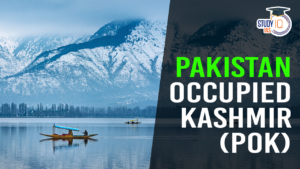 Pakistan-Occupied Kashmir (PoK): History...
Pakistan-Occupied Kashmir (PoK): History...

